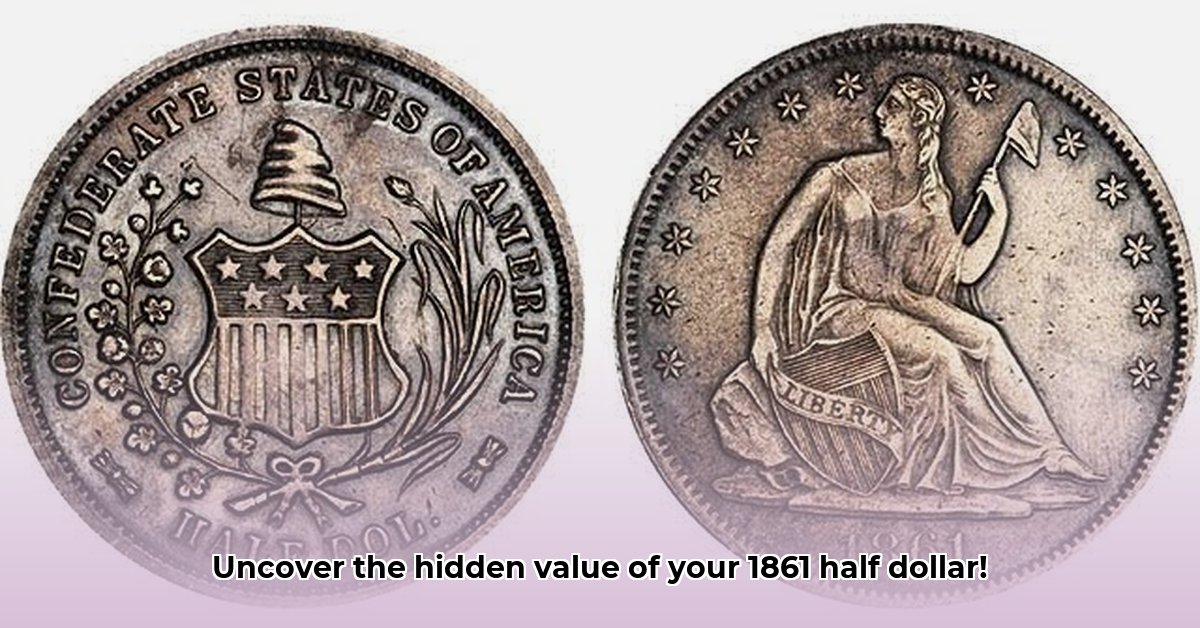
The 1861 Seated Liberty Half Dollar: a captivating glimpse into American history, now a sought-after collectible. But its value isn't static; it's a dynamic interplay of mint mark, condition, and market forces. For more on valuable half dollars, see this guide on 1912 Half Dollar Values. This guide provides a comprehensive look at determining the value of your 1861 half dollar, whether you're a seasoned numismatist or a curious newcomer.
Unveiling the 1861 Seated Liberty Half Dollar
Minted during the Civil War era, the 1861 Seated Liberty Half Dollar, designed by Christian Gobrecht, showcases Lady Liberty seated, a potent symbol of the time. Composed of 90% silver and 10% copper, this coin weighs approximately 12.5 grams and measures 30.6mm in diameter. However, its true worth depends on subtle yet significant details.
The Significance of Mint Marks: "P" vs. "S"
The 1861 half dollar was minted in two locations: the Philadelphia Mint (marked "P") and the San Francisco Mint (marked "S"). This seemingly minor detail dramatically impacts value. The Philadelphia Mint produced over 2.8 million 1861-P coins, while the San Francisco Mint produced a significantly smaller number, approximately 940,000 1861-S coins. This difference in mintage directly affects rarity and, consequently, value. The rarer 1861-S commands a higher price due to simple supply and demand. How much higher? Let's explore that.
Coin Condition: A Crucial Valuation Factor
A coin's condition is paramount in determining its value. Think of it as the difference between a pristine classic car and a rusty wreck. Numismatists employ the widely accepted Sheldon Scale to grade coins, ranging from Poor (1) to Mint State 70 (MS-70). Each grade reflects the coin's wear and tear. Scratches, dents, and surface imperfections all impact its condition rating.
- Poor (1-3): Heavily worn, many details obscured.
- Fair (6): Main design features visible but significantly worn.
- Good (8): Most details visible, though significant wear is present.
- Very Fine (VF-20): Minor wear, overall good condition.
- Extremely Fine (XF-40) to Mint State (MS-70): Minimal to no wear, sharp details, and lustrous surfaces. These are the true collector's gems.
Price Ranges: A Market Snapshot
The table below provides estimated price ranges for various grades of 1861-P and 1861-S half dollars. These are estimates based on recent market trends and should be considered guidelines, not guarantees. Prices fluctuate due to market forces and specific coin attributes. Always consult multiple reputable sources for the most current valuations.
| Coin Type | Grade | Approximate Price Range (USD) |
|---|---|---|
| 1861-P | MS60 | $200 - $500 |
| 1861-P | AU50 | $100 - $300 |
| 1861-P | G4 | $50 - $150 |
| 1861-S | MS60 | $500 - $1500 |
| 1861-S | AU50 | $250 - $750 |
| 1861-S | G4 | $150 - $400 |
Note: These are estimates. Auction results and dealer prices vary.
Investing in 1861 Half Dollars: Considerations
While investing in numismatic coins can be rewarding, it also involves risks. Silver prices directly influence melt value—the amount the coin is worth if melted down for its silver content. Market fluctuations can impact prices significantly. Furthermore, counterfeits exist, demanding careful authentication before purchase.
Where to Buy and Sell: Ensuring Authenticity
For buying and selling, choose reputable coin dealers, auction houses, or established online marketplaces. Thorough research is essential, especially for online transactions. Never rush a purchase; verify authenticity and compare prices from multiple sources.
Conclusion: The Value Equation
The value of an 1861 Seated Liberty Half Dollar rests on a combination of factors: its mint mark ("P" or "S"), its condition (graded using the Sheldon Scale), and prevailing market conditions. Understanding these elements is crucial for accurately assessing the worth of this historic coin. Remember, diligent research and a cautious approach are key in the world of numismatics.